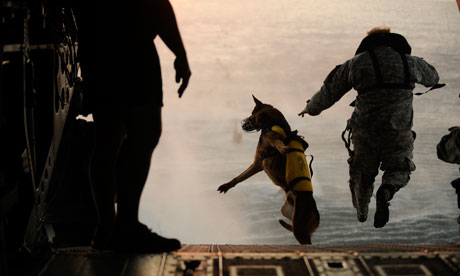Sunday 15 May 2011 20.00 BST
- Article history

None of their identities are known, of course, but one member of the team of US navy Seals that killed Osama bin Laden has become the star: the dog. Since being mentioned in the first reports of the raid, details of this elite animal have become as sought after as the man it helped to catch.
What breed was it, for example? (Alsatian, malinois, or possibly a labrador, which is popular with the US marines in Afghanistan. British forces prefer spaniels.) Did it actually rappel down from the helicopter? (It seems so, yes, with help.) What was it wearing? (A bullet-proof vest with a two-way audio-visual communications system.) Did it have titanium-tipped teeth, as some papers claim? (Don't be silly.) What does it eat? (Carpaccio of evil-doer, twice a day.)
Yet the use of dogs in war is far from new. According to legend, a dog fought for the Greeks against the Persians at the battle of Marathon in 490BC. The Greek historian Strabo also reports that ancient Britons used their hunting dogs for waging war. More often, though, dogs have been used as trackers, messengers or guards.
The German shepherd owes its popularity almost entirely to its success in the first world war. Having created it deliberately as a guard dog, the breeder Max von Stephanitz cunningly offered them to the German army for free. By 1918, 48,000 were in service, and became so popular they were taken home by British and US forces after the war (the name "alsatian" was hastily devised, to shed their association with the enemy).
Somewhat shockingly, a unit of "anti-tank dogs" was also used, by Soviet forces during the second world war. They were expected to run at enemy tanks with bombs strapped on their backs, which would explode on impact. But their unreliability in distinguishing between German and Russian tanks – and their fondness, when confused, for running back to their handlers – made this a mercifully brief experiment.
Today, the use of dogs within the British and US military is increasing, thanks to their unrivalled skill in sniffing out hidden explosive devices. And there are even canine medals – last year a black labrador called Treo was awarded the equivalent of the Victoria Cross for finding hidden bombs in Helmand province by veterinary charity the PDSA. A further 26 other dogs have also won the award, introduced in 1943.

No comments:
Post a Comment